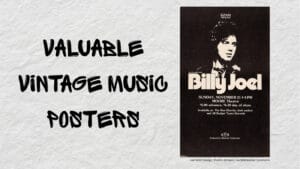Are you a die-hard music fan? If yes, then you must have one of those vintage music posters of Elvis Presley or the Beatles in your room. If you’re nodding, think of yourself lucky, as these promotional materials could be worth a big fortune today! And we’re talking thousands of dollars, here!
In this guide, I’m going to show you some of the most valuable examples of vintage posters worth money, plus some easy tips to identify, authenticate, and find out what really so collectible today.
13 Most Collectible Vintage Music Posters Worth a Lot of Money!
If you’re into collecting music posters or want to sell the ones piled in your room, you must check this list of the most valuable examples with premium collectible value. And we’re talking thousands!
1. The Grateful Dead Avalon Ballroom Poster (1969)
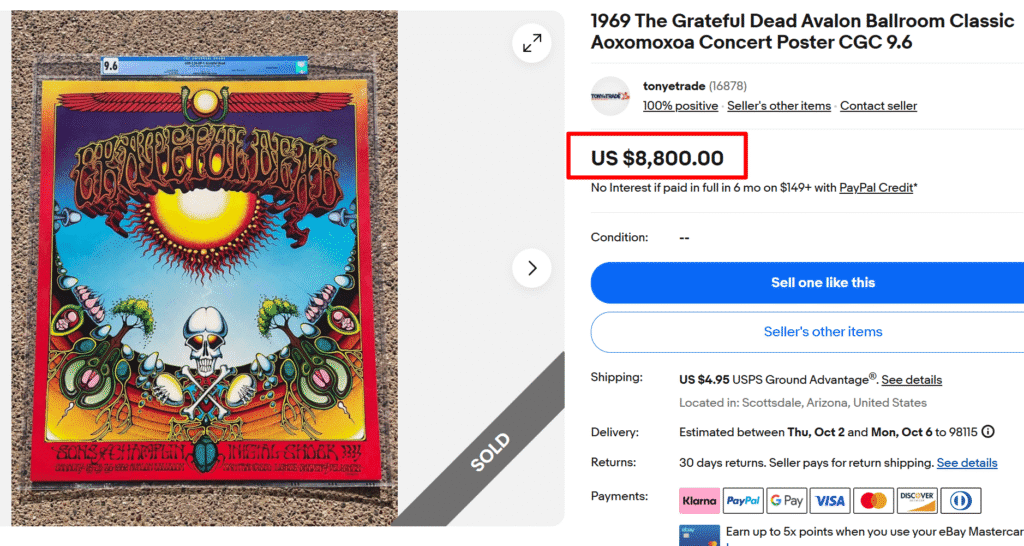
Rick Griffin designed this iconic poster for the Dead’s January 1969 Avalon Ballroom show. The image was later used as cover art for their third album.
This design became one of the most requested Grateful Dead images of all time and has been reprinted twice, with a 1976 European limited edition of 3,000. The vibrant artwork features Griffin’s signature psychedelic style with Egyptian-inspired imagery, skulls, and kaleidoscopic patterns.
Original first printings (around 22 x 26 inches) with original pre-concert printing (OP-1) command premium prices in high grades, like this CGC 9.6 example, sold for $8,800!
2. The Doors Kaleidoscope Round Concert Poster
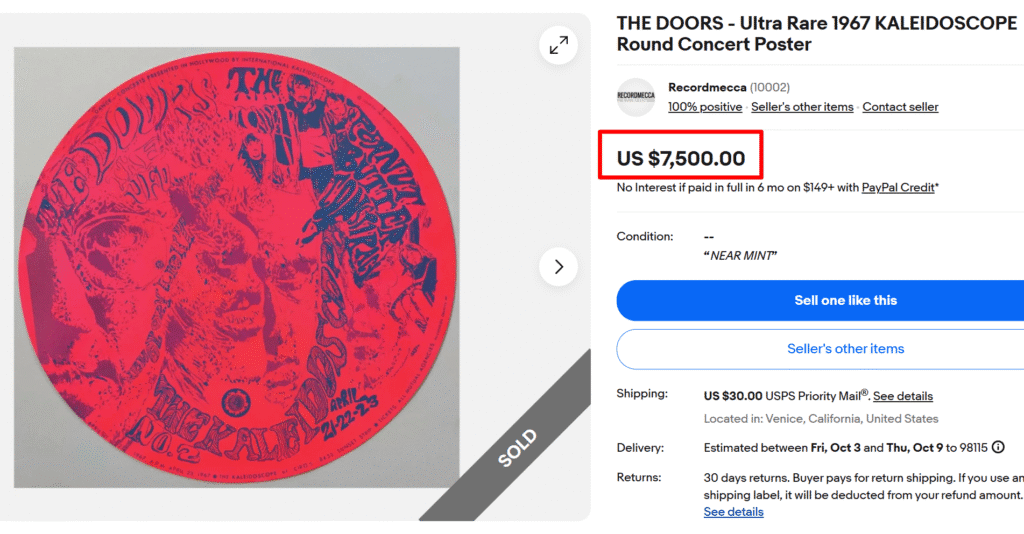
This circular poster from April 21-23, 1967, is the rarest piece in the Kaleidoscope series and one of the most sought-after Doors collectibles. It’s believed to be the first concert poster featuring an image of the band, close-up portraits of all four band members printed in striking day-glo colors.
Artist John Douglas Kline created it using day-glo fluorescent ink, which makes it incredibly fragile and scarce. Printed on thin paper stock, original prints are extremely difficult to find in good condition, making them worth $5,000 to $10,000 or even more.
3. Pink Floyd Pirates World Concert Poster (1972)
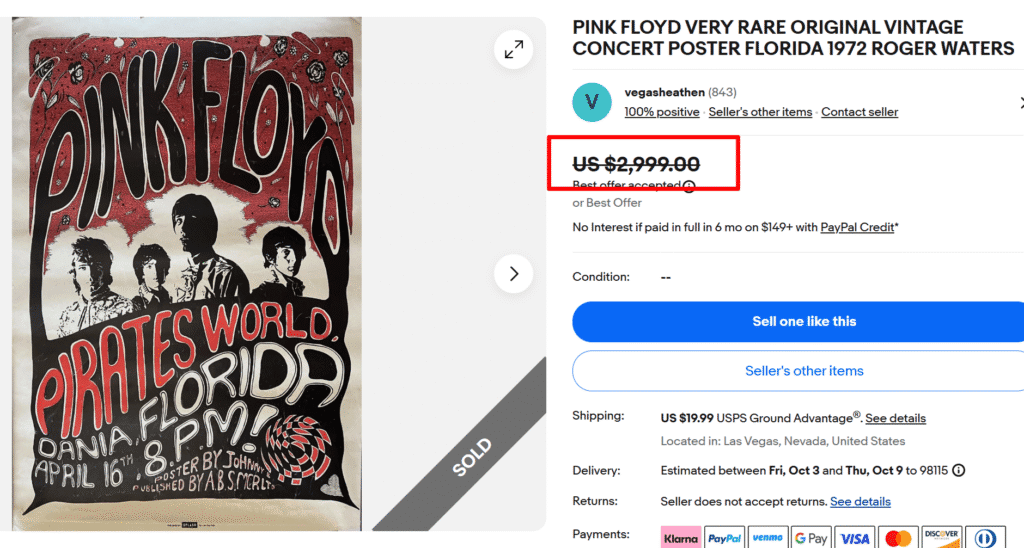
This is an April 16, 1972, Pink Floyd poster from Pirates World in Dania. The psychedelic red and black design features all four band members with “Pirates World Florida” branding.
This show happened in the “Meddle” era, when the band was creating material that would become “Dark Side of the Moon.” Also, Pirates World existed between 1967 and 1973 and featured spectacular rock concerts before its closure when Disney World opened, so these posters are rare.
4. Bob Dylan Syracuse University Concert Poster (1963)
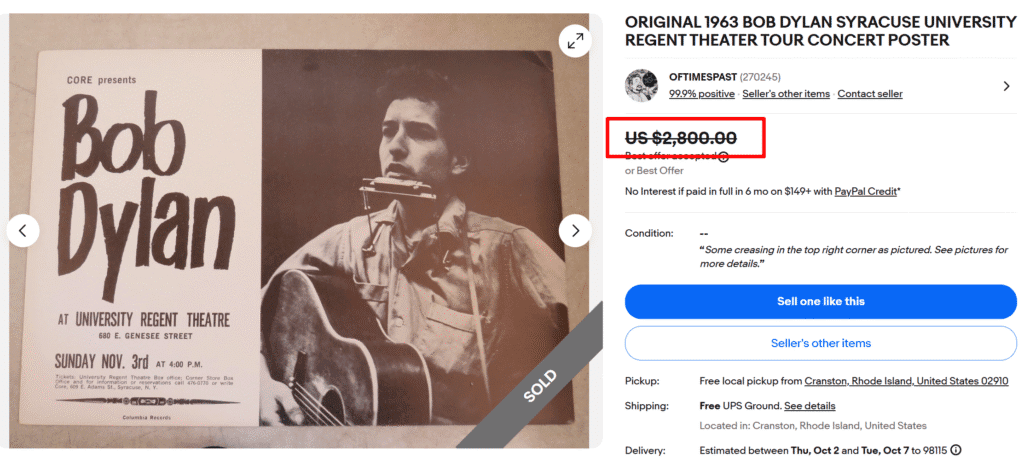
This is the folk-era Bob Dylan from 1963, before he went electric and shocked the world. It’s from his show on November 3rd at Syracuse University’s Regent Theater, his acoustic coffee-house phase, probably playing songs from “The Freewheelin’ Bob Dylan.”
The poster shows a simple, stark, minimalist folk-style design with just his name in brown lettering and that iconic photo. Dylan posters from his pre-fame period are incredibly rare, often selling for a few thousand dollars in good condition.
5. Elvis Presley I’m Left HMV Record Store Promo Poster (1958)
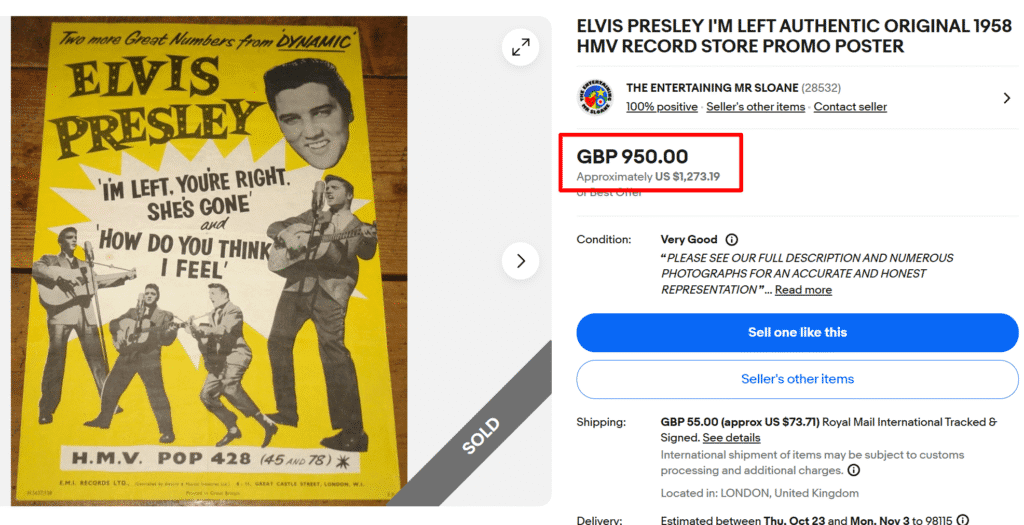
This bright yellow HMV (His Master’s Voice) UK promotional poster from 1958 is pure gold for collectors. It advertises Elvis’s single “I’m Left, You’re Right, She’s Gone” and “How Do You Think I Feel,” songs from his early RCA period. The dynamic photos and bold typography show rockabilly Elvis before his army service.
It’s a genuine record store display piece from London with the EMI Records Ltd. type and Great Castle Street address. Such in-store promos were made to be thrown away once the promotion ended. That’s why surviving examples are incredibly rare.
6. The Who Concert Poster (1968)
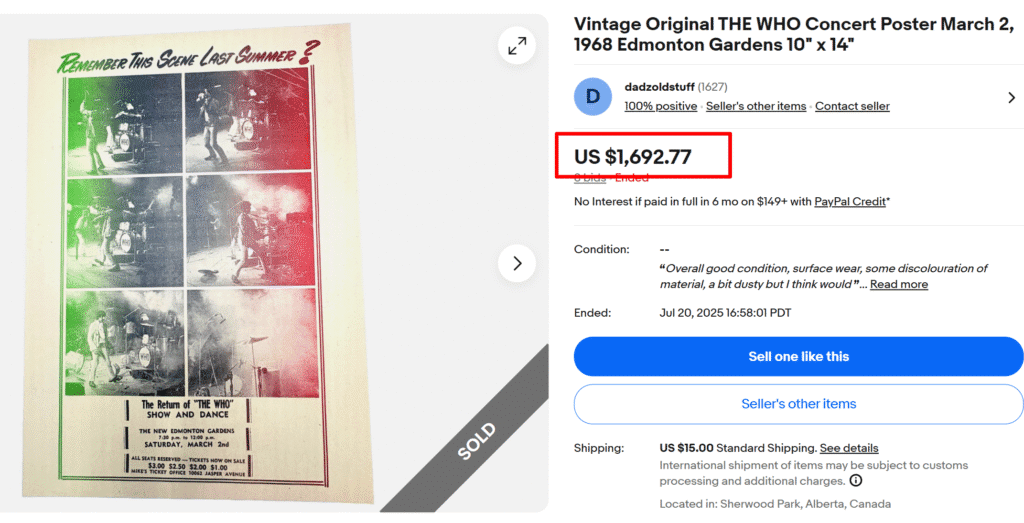
An original “The Who” poster from 1969 with that iconic “Remember This Scene Last Summer?” tagline and tri-color photo grid is a collector’s dream. The show was at Edmonton Gardens, Canada, a 5,200-seat hockey venue which welcomed top rock acts in the late ’60s.
Canadian concert posters are unique and usually rarer than their U.S. counterparts as fewer were made. Look for surface wear and staining, and do not mistake coloring with damage.
7. Nirvana Concert Poster (1991)
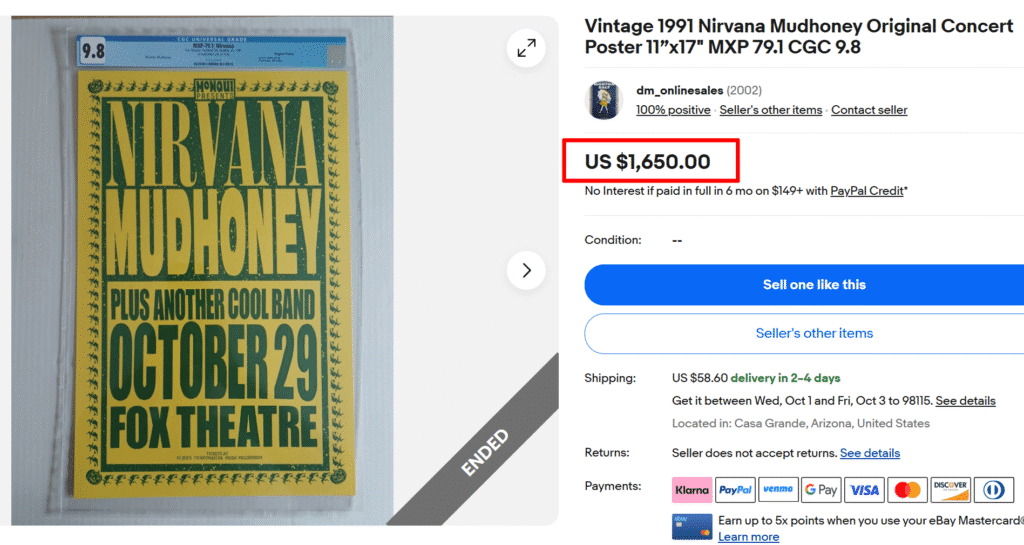
This poster is from Nirvana’s pre-fame days at the Fox Theatre in Boulder. This October 1991 show happened just weeks after “Nevermind” dropped but before “Smells Like Teen Spirit” exploded everywhere, making it a snapshot of the moment before overnight fame.
The simple, bold typography and yellow/green color scheme are the early ’90s Pacific Northwest design. Besides, this example has been professionally graded 9.8 by CGC, making it authentic. Such original Nirvana posters from 1991 are quite rare and valuable today.
8. Led Zeppelin Concert Handbill (1970s)
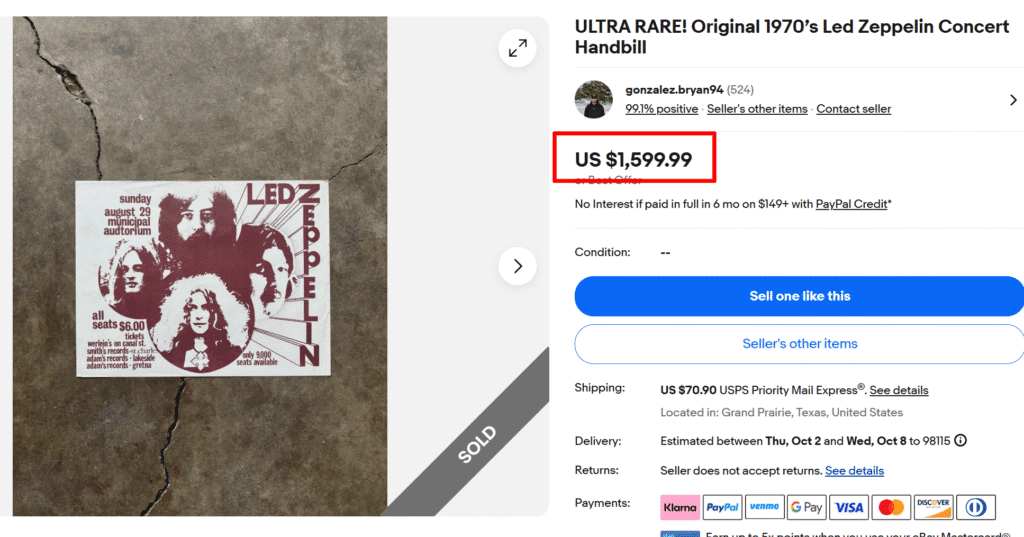
Concert handbills are often rarer than full-size posters because people tossed them after the show. This Led Zeppelin handbill in the classic ’70s burgundy-toned photographic design from Municipal Auditorium shows the band when they were the biggest rock act on the planet.
These handbills are special. They were handed to people walking into the venue. Only 3000 seats were available for this show, so they’re quite rare to find. Original Led Zeppelin concert materials from the ’70s often fetch top dollar because the band’s legacy only grows stronger.
9. Janis Joplin Concert Poster & Postcard (1969)
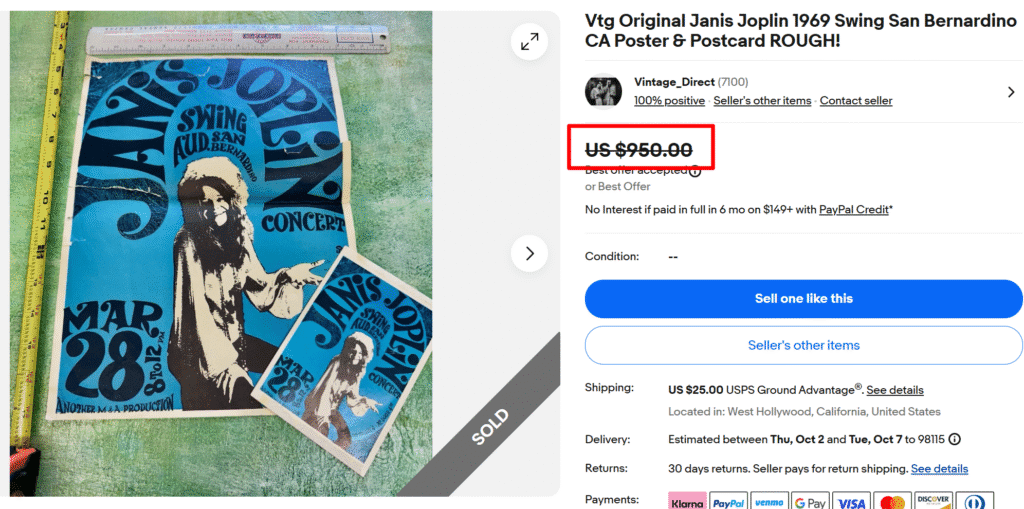
This 1969 poster was made when Janis was in her solo phase with the Kozmic Blues Band after leaving Big Brother and the Holding Company. It shows the psychedelic blue design with her unmistakable silhouette in the classic late-60s style.
Besides, it’s a set of both the poster and postcard from the same show, with The MC5 and Lee Michaels opening at the Swing Auditorium. Collectors love posters from this venue as most popular names, from Hendrix to Led Zeppelin, played there. Plus, it was demolished in 1981, making these posters quite rare.
10. Creedence Clearwater Revival Poster (1969)
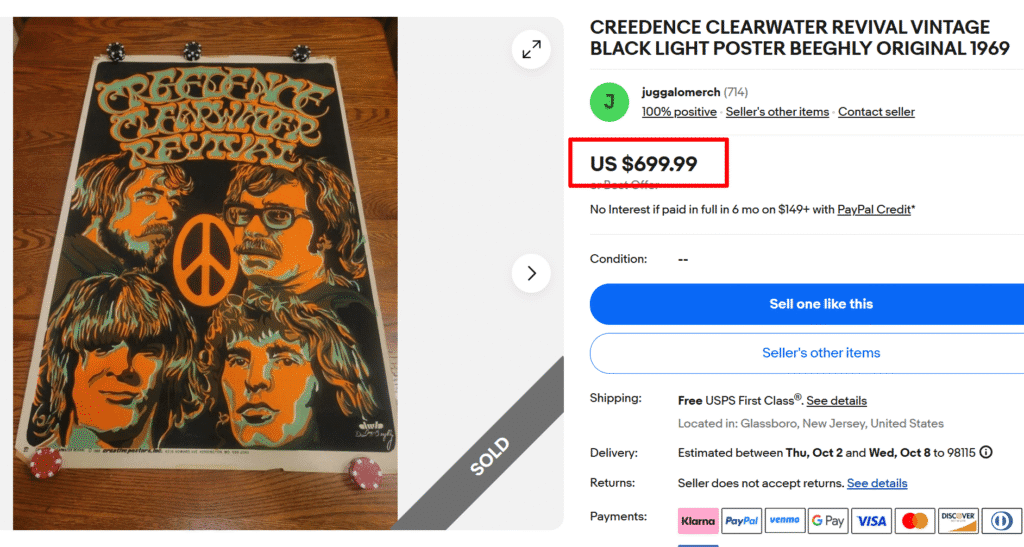
This late ’60s CCR blacklight poster by renowned artist Dail W. Beeghly is an example of psychedelic headshop art. It features all four band members with the iconic peace symbol, capturing CCR at the height of their fame after hits like “Proud Mary” and “Bad Moon Rising.”
Beeghly was also renowned for employing fluorescent day-glow inks which glow under a UV light for posters. Original Beeghly posters from this period are super rare and command premium prices because so few survived in good condition.
11. The Beatles Indianapolis State Fairground Concert Poster (1964)
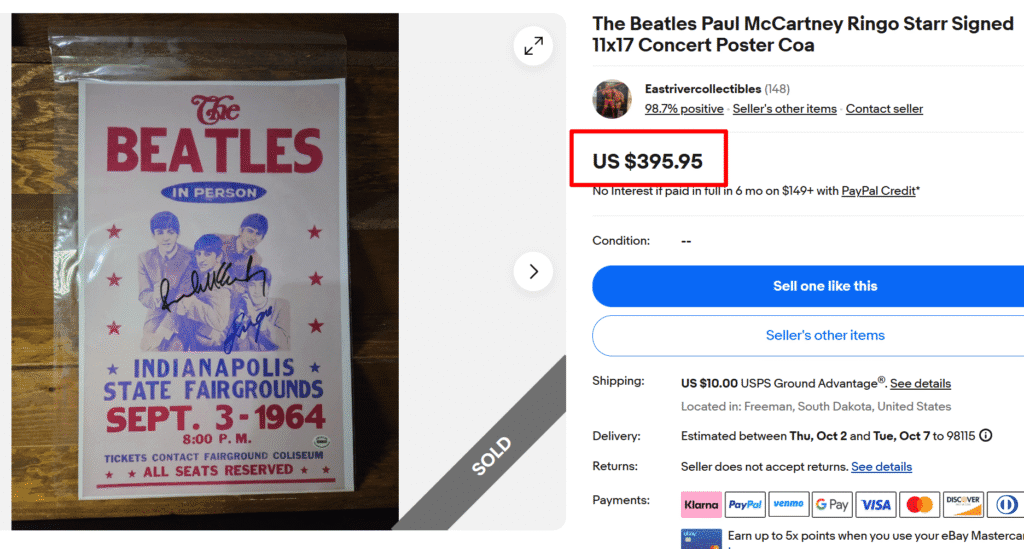
This poster promoted The Beatles’ sole Indianapolis concert in September 1964, when they performed two performances for 29,337 fans at the Indiana State Fair Coliseum. It shows an elementary, yet bold, design with “The Beatles In Person” words and pictures of the Fab Four.
These posters become extremely valuable when signed by band members such as Paul McCartney and Ringo Starr.
12. Andy Warhol’s The Velvet Underground Era Posters (1966)
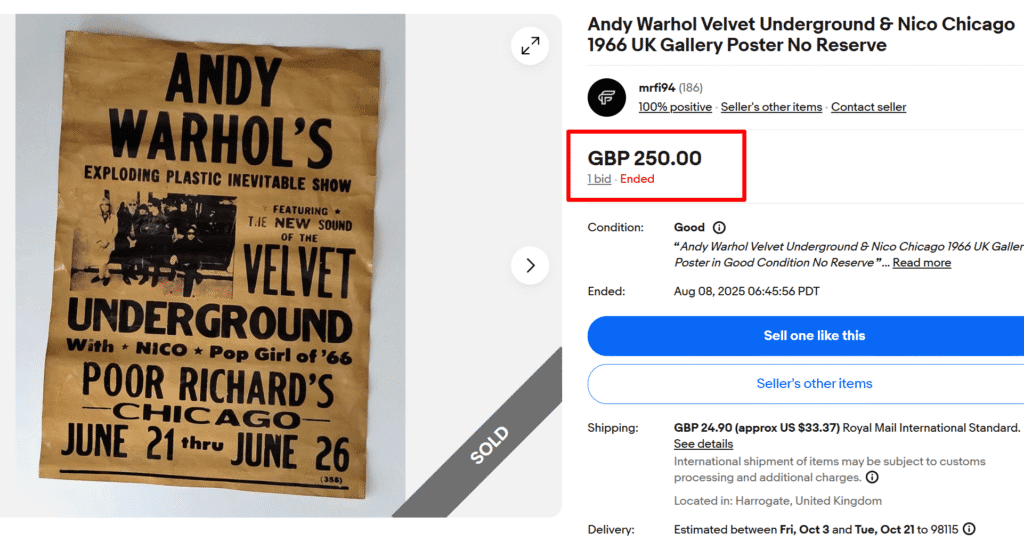
This rare poster for Poor Richard’s advertised Warhol’s “Exploding Plastic Inevitable” multimedia show in 1966, featuring the Velvet Underground with Nico. The simple brown paper aesthetic with stark black typography matches Warhol’s Factory style.
Note that this is a UK gallery piece rather than an original 1966 venue poster. That’s why this one sold for more than $300; authentic 1966 Velvet Underground posters are museum-quality collector’s items in tens of thousands of dollars, so check the printing date very carefully.
13. The Grateful Dead Skull and Roses Tour Poster (1971)
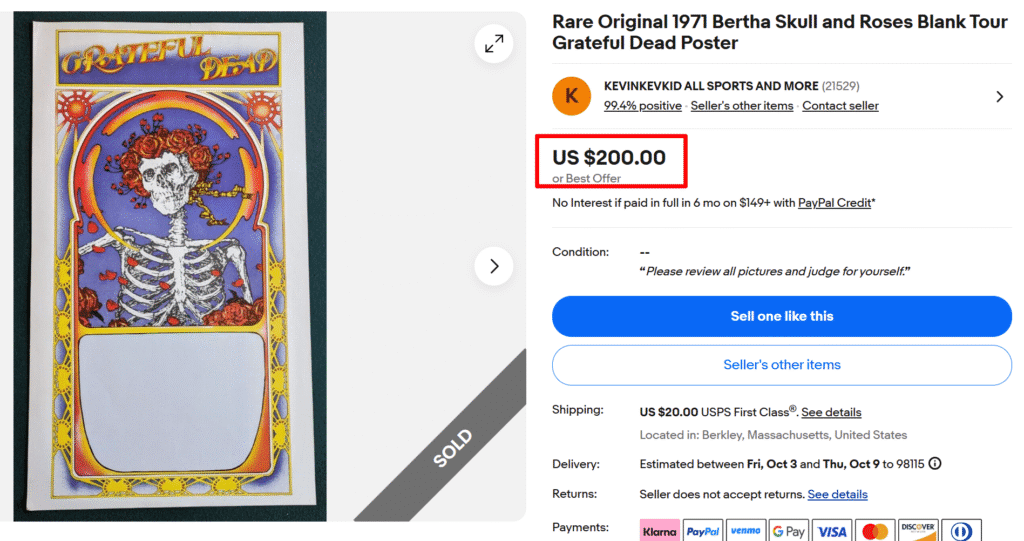
This 1971 “Bertha” poster features the classic skull and roses image that came to define Grateful Dead culture. The Art Nouveau art featuring the skeleton dressed in roses is a representation of the band’s distinctive mix of psychedelia and death imagery.
What is unique about it is it’s a blank tour poster, so it has space on the bottom where the specific venue information would be filled in locally. These blanks were distributed to promoters nationwide who’d stamp in their show details. Original blanks can be quite rare.
Identifying Authentic Vintage Posters – 5 Signs to Spot
Authenticating an original old poster involves looking beyond the artwork itself to check how it was created. The technical things, like every fold, every ink spot, every tiny flaw, can inform you when and how the poster was printed and whether or not it’s a real piece.
Printing Style
The way a poster was printed is one of your best clues to whether it’s real. Vintage posters from different eras used specific printing methods, which modern reproductions can’t fake. These styles will not only help you spot the authentic examples, but also date them.
1. Stone Lithography (1870s-Early 1900s)
This is one of the oldest methods that involved drawing directly on limestone slabs using greasy crayons. Each color needed its own stone. Under magnification, you’ll see some similar to watercolor painting; the colors flow smoothly with no dot patterns.
Real stone lithograph posters may have hand-added stipple dots for shading. These dots are of different sizes, with slightly wonky placement since they were applied by hand with a roller or brush.
Collector’s Tip: In early lithography, the oil-based ink soaks through to the back of the paper. So, if you see a faint ghost of the image on the reverse, it’s a piece from the pre-1920s.
2. Chromolithography (Late 1800s-1940s)
This has the same basic process as stone lithography, but with multiple colors. One stone for each color, all layered up to create the final image. The prints look like chalk drawings or crayon sketches, something like gouache paintings. But there are no modern halftone dots.
Some early 1900s posters show a hybrid approach. Printers used black halftone dots in some areas but kept other colors solid. This in-between style looks nothing like modern printing.
3. Offset Lithography (1950s-Present)
This became the go-to method for those famous psychedelic Fillmore and Avalon posters in the ’60s and ’70s. It involves applying the ink from a plate to a rubber blanket, then onto the paper; the ink looks thin and watery.
You may also see the image showing through from the back on that lightweight paper stock when held against the light. Plus, early offset prints have irregular dot patterns compared to modern digital printing.
4. Screen Printing/Silkscreen (1960s-Present, Dominant 1980s onward)
Screen printing adds a thick layer of ink on top of the paper, which you can feel with your fingers. That thick ink can crack over time. So, the cracks prove the poster is old. Each color needs its own screen, so you get clean color separation with no dots in the solid areas.
Marks and Indicators
Most vintage posters show certain marks, types, and signs on them that tell about which company or label printed, distributed, or commissioned them. Spotting these signs will help you differentiate real ones and fakes.
Printer Marks and Copyright Information
Authentic vintage posters often have specific identifying marks that reproductions either miss or incorrectly copy.
Union Labels:
Pre-1980s posters often show union printer labels, especially from organizations like the Allied Printing Trades Council or local printer unions. These labels evolved with specific design changes that can help date a poster. Check for the presence and correct format of union labels for the given era to identify it.
Printer Information:
Look for small print (mostly at the bottom margin) identifying the printing company. Famous printers include Bindweed Press (San Francisco), West Coast Lithograph Company, Theatrical Poster Service, Globe Poster Company, and Murray Poster Company.
Copyright Dates and Symbols:
Most authentic posters also have copyright markings consistent with the era. Up to 1989, the format of the copyright symbol (©) was conventional. Post-1964 copyrights will usually contain the ® symbol for registered trademarks.
Duplicates tend to adopt modern copyright formats that weren’t available in the era of the original poster.
Artist Signatures and Attribution
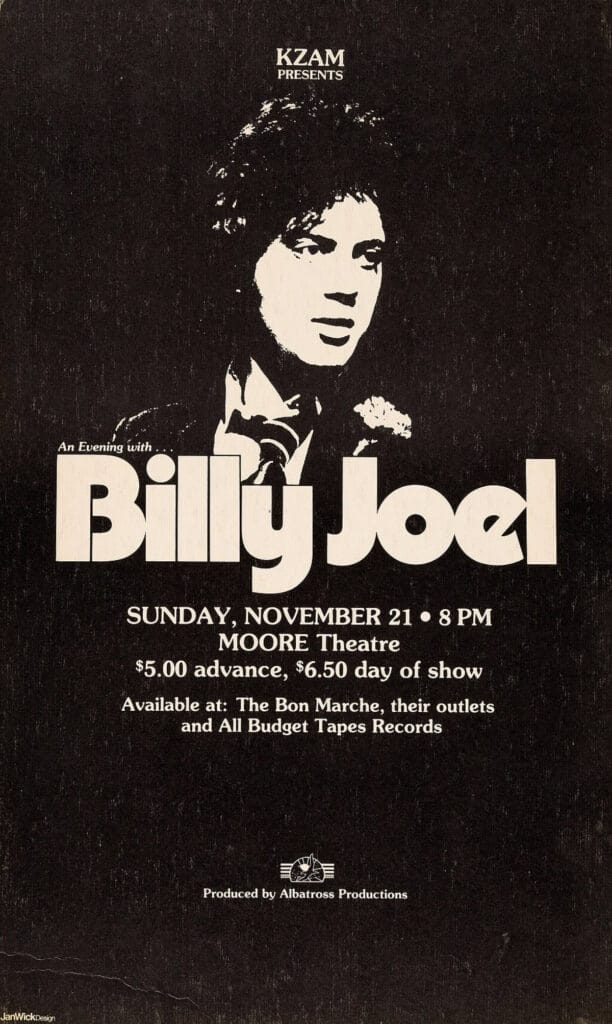
Certain poster artists, particularly the “Big Five” psychedelic artists: Wes Wilson, Rick Griffin, Stanley Mouse, Alton Kelley, and Victor Moscoso, tended to sign their artwork. Look for them by their telling marks, including:
- Wes Wilson: Shows unique flowing, melting letterforms. His signature often looks integrated into the design or in small print at the bottom.
- Rick Griffin: Shows his “eyeball” motif and intricate Art Nouveau-influenced designs. His work on the Bill Graham series (particularly BG-105, the “Flying Eyeball” Jimi Hendrix poster) is highly collectible.
- Stanley “Mouse” Miller: He often worked collaboratively with Alton Kelley. You may find his iconic “Running Mouse” signature on many posters. It was the Mouse/Kelley team who created the iconic Grateful Dead “Skeleton & Roses” image.
- Victor Moscoso: He’s probably the only formally trained artist among the Big Five. His work usually has sophisticated color theory with clashing complementary colors.
Collector’s Note: Artist signatures can be printed as part of the original design or hand-signed in pencil or pen after printing. Hand-signed examples are the most desirable, but the signature must be authenticated.
Numbered Series and Edition Marks
Posters also show edition markings. These will help you spot the edition, of course, but also help you in valuation:
- First Printings vs. Reprints: The Bill Graham or BG series (commissioned by the legendary concert promoter, Bill Graham) used a numbering system. The first printings have “-1” after the number (e.g., BG-105-1), second printings have “-2,” and so on. The first printings are worth the most!
- Handbills and Postcards: The early BG posters (numbers 0-45) were made in three formats: full posters, handbills, and postcards. The first 24 handbills were printed in black and white on thin paper at 5″ x 7″ and are extremely rare. After number 45, only posters and postcards were produced.
- Edition Numbers: Limited edition reprints or authorized reissues may include pencil notations like “167/350” indicating the print number and total edition size. These likely appear in the margin below the image area.
Era-Specific Cultural and Design Cues
The design style of a poster is another important clue to guessing its age. Be it the unique “head-only” design or the dense text-only design, different eras brought different changes to the poster designs:
1. Boxing Style (1940s-Early 1960s):
Named for its resemblance to boxing match posters, this poster style featured:
- Bold, block lettering with clear hierarchy
- Black and white or limited color palettes
- Straightforward information presentation
- Minimal decorative elements
- Emphasis on performer names and venue details
Popular examples include early Beatles, Rolling Stones, and Chuck Berry posters before the psychedelic era began.
2. Psychedelic Era (1965-1972):
The psychedelic style came from San Francisco and was heavily influenced by LSD and the consciousness-expansion movement. Spot these signs to identify this revolutionary poster style:
- Flowing, “melting” letterforms inspired by Art Nouveau
- Vibrant, often clashing colors
- Dense compositions that need a closer look to read
- Use of cultural iconography (peace symbols, Eastern mysticism, nature imagery)
- Influences from artists like Alphonse Mucha and Edmund Joseph Sullivan
- Intentionally difficult readability to attract attention
3. Punk and New Wave (Mid-1970s-1980s):
These retro posters commonly show:
- Photocopied flyers and low-budget looks
- Cut-and-paste ransom-note lettering
- Raw, aggressive imagery
- Social and political messaging
- Intentional amateurism as artistic statement
What Makes Vintage Music Posters Valuable?
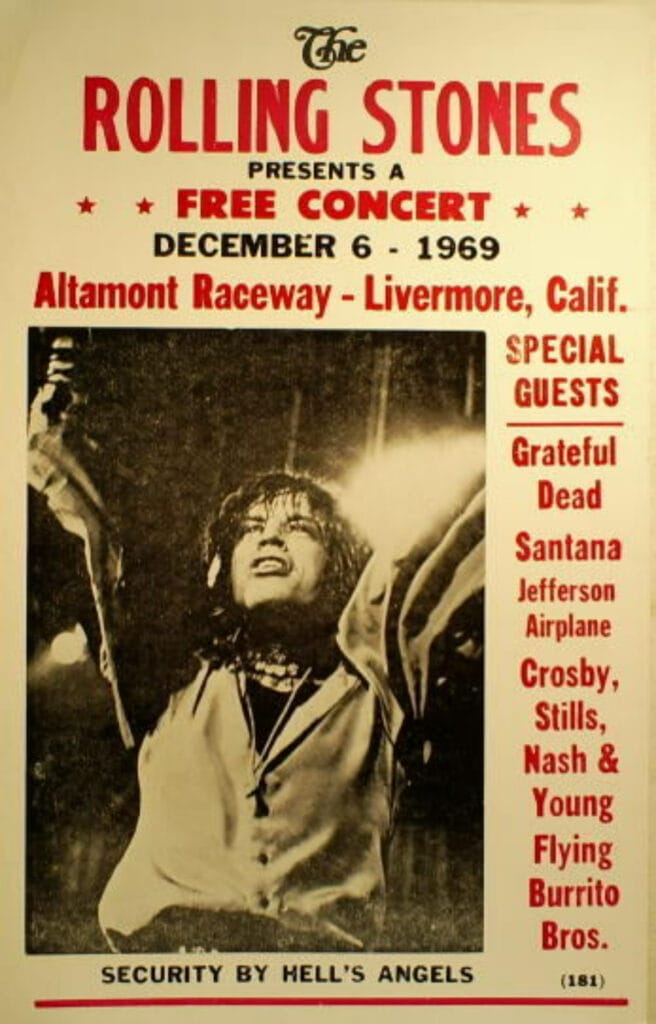
Truth be told, vintage posters can be worth as little as $5 and as much as $100,000 or even more. Several factors are responsible for this steep difference in the price range.
Here’s a breakdown of what really makes vintage posters worth the money and what you need to assess to know whether one is worth just a few bucks or five/six figures.
Age
Age is probably the most vital factor affecting a vintage poster’s supply and value. Why? Because posters weren’t always as popular. Moreover, fewer high-quality examples survived with every passing decade.
So, a 1968 poster is worth more than the 1988 one, not just because of the era, but because fewer were printed and they’ve been exposed to decades more wear, damage, and loss.
But not all damage is a warning sign. Some are actually signs of natural aging and authenticity.
- Patina and Acidity: Vintage posters were printed on low-quality, acidic wood pulp paper. Over the decades, the acid causes natural browning or tanning across the entire poster. The patina develops naturally and can’t be faked on modern posters.
- Paper Brittleness: Genuine unrestored paper from the 1960s or earlier generally feels dry, crisp, and brittle at the edges. The poster lacks the smooth, flexible feel of modern paper.
- The UV Test: Genuine vintage paper doesn’t contain optical brightening agents, which were introduced later. Under a UV (black) light, an authentic poster appears dull and dark. A modern reproduction glows bright blue or white.
- Natural Fold Wear: Posters shipped folded (standard practice before 1980) show subtle wear along the fold lines or minor breaks in the ink and slight paper thinning. This natural aging is nearly impossible to counterfeit authentically.
Condition
Small condition differences create large value differences for vintage posters. Generally, a new-like poster without any visible damage can sell for five to ten times more than the same poster in average or bad condition.
Here are the actual damage signs that can seriously affect the value:
- Any rips, especially those leading to a loss of the original artwork or border
- Excessive or large holes (small holes from being posted are common)
- Any moisture damage, food stains, or foxing (the small brown spots caused by mold or iron impurities)
- Irreversible color fading (sun bleaching) due to exposure to sunlight or harsh artificial light
- Masking tape, duct tape, or other non-archival adhesive stains or evidence of use
- Dry mounting or gluing the poster onto a board
- Permanent hard creases or accidental folding outside of the original ship fold
Although you can identify these damages yourself, there are professional grading companies, such as the Certified Guaranty Company (CGC), that help in grading the poster from 0 to 10 according to condition. They also encase the poster in a tamper-evident holder and give grades such as Mint 9.8.
CGC-graded posters consistently bring higher prices. A CGC-graded poster generally commands 20-40% more than an identical ungraded poster in seemingly similar condition.
Rarity
The value of a music poster largely depends on how rare it is or how difficult it is to find. But rarity is not just about the number printed; it’s about the number that survived. Depending on different aspects, here’s what makes an old poster rare:
- Limited Local Printings: Early Fillmore and Avalon Ballroom posters were printed in runs of 800-1,200 copies, with only a fraction surviving. Some specialized venues printed only 40-50 copies. These low print runs drive up their value.
- Multiple Printings: Popular shows were sometimes reprinted, creating first printings (-1), second printings (-2), and sometimes third printings (-3). First printings are typically worth 3-10 times more than authorized later printings of the same design.
- Survival Rates: Posters were handled manually, and most were torn down, thrown away, or destroyed after the event. Almost 99% of original concert posters were discarded, making the surviving ones extremely rare and valuable.
- Geographic Distribution: Posters released for regional or single-venue events have limited distribution and higher rarity than national tour posters produced in quantity and distributed widely.
- Pre-Fame Posters: Posters promoting bands prior to being renowned are very rare since print runs were shorter and fewer people had them. Early Beatles posters from Hamburg or Liverpool club dates, or Grateful Dead concerts prior to becoming worldwide famous, may fetch $50,000-$150,000.
Historical & Cultural Significance
Posters that have a strong history or cultural significance are worth way more than common posters.
- Final Performances: Posters from concerts that were an artist’s final performance are extremely rare. The Beatles’ 1966 Shea Stadium poster from their final tour and The Grateful Dead’s Winterland closing show (New Year’s Eve 1978) are perfect examples.
- Tragic Events: Posters promoting the Altamont Speedway free concert, where bloodshed and fatalities took place, or the Winter Dance Party tour with Buddy Holly, only days before the fatal plane crash, have historical significance that adds value.
- Festival Posters: Woodstock, Monterey Pop Festival, and other iconic cultural phenomena generated classic posters worth many times more than standard concert promotion.
- Venue Closing/Opening Shows: Initial shows at iconic venues or last performances prior to closure are rare. The first Fillmore Auditorium poster (BG-1, Jefferson Airplane in February 1966) or final shows carry premium values.
- Cultural Icons: The Beatles, Rolling Stones, Jimi Hendrix, Grateful Dead, Led Zeppelin, and other era-defining artists command the highest prices. Even regular posters of these acts sell from $500-$2,000, with first-time appearance ones selling for six figures.
- Artist Peak Period: Posters from an artist’s creative peak or most influential period are more valuable than those from later careers. Rolling Stones posters from their 1964-1972 artistic peak are more sought-after than 1980s tour posters.
Provenance
Documentation of a poster’s ownership since printing is a great clue of authenticity and can boost its value. For example, posters that have been displayed in museum exhibitions or included in published books/catalogs are highly collectible.
Period photographs showing the poster being displayed, original purchase receipts, or correspondence with the venue/artist provide strong authentication. Similarly, previous ownership by well-known collectors or public figures also adds cachet and value.
A poster with solid documentation can be worth a lot.
Note: This article is intended for informational, educational, and entertainment purposes only. Some images are illustrative and may not represent actual brands, products, or related entities. All trademarks, product names, brand logos, packaging, and other intellectual property referenced remain the exclusive property of their respective owners. Any brand mentions or references are provided solely for descriptive and educational context and do not imply any formal or commercial association.

